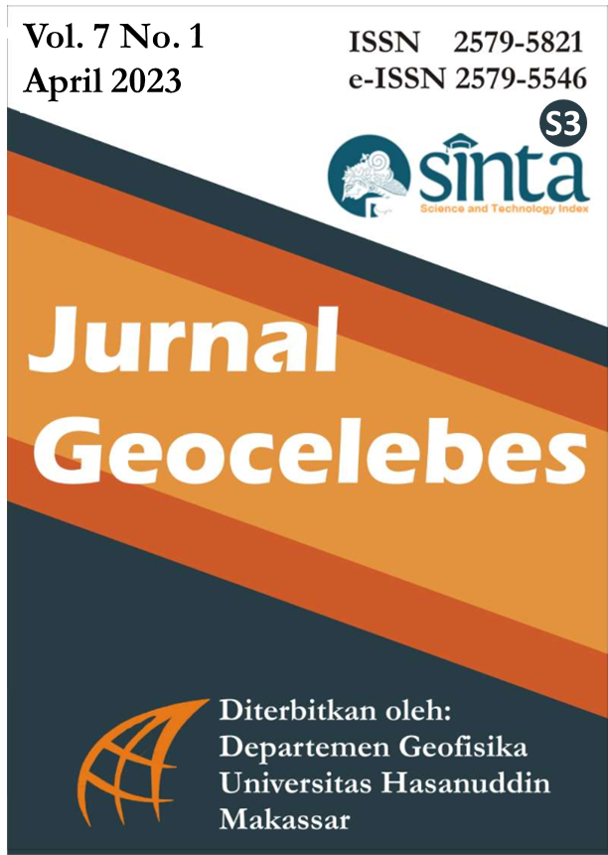Application of Self-Potential Method in Mapping Leachate Flow Around Rasau Jaya Landfills, Kubu Raya Regency
Penerapan Metode Potensial Diri (Self Potential) dalam Memetakan Aliran Lindi di Sekitar TPA Rasau Jaya Kabupaten Kubu Raya
DOI:
https://doi.org/10.20956/geocelebes.v7i1.20524Keywords:
leachate, self potential, landfill, Rasau JayaAbstract
This study uses the self-potential method to map the leachate flow around the Rasau Jaya landfill, Sungai Raya District, Kubu Raya Regency. The study was carried out in 2 areas, the north and south of the landfill. Data acquisition using a fixed base configuration by applying ten lines. Each line has a length of 105 m with 5 m, and the distance between the porous pots is 5 m. The measurement results show that the potential value distribution at the first location is -19.62 mV to 8.44 mV, and the potential value at the second location is -55.50 mV to 23.26 mV. The interpretation shows that leachate accumulation from the landfill in the first area has a potential value of -19.62 mV to -13 mV. The second location has a potential value of -55.50 mV to -36 mV. Based on isopotential contour maps, leachate accumulation in the first location is thought to be in the north to northeast of the landfill, while in the second location, it is thought to be in the southwest to the west of the landfill.Downloads
References
Bavitra. (2018). Interpretasi Sebaran Aliran Fluida Kontaminan Menggunakan Metode Self-Potential (SP) Pada Tempat Pembuangan Akhir (TPA) Sampah Sarimukti, Kabupaten Bandung Barat. In Institut Teknologi Bandung.
Goto, T. N., Kondo, K., Ito, R., Esaki, K., Oouchi, Y., Abe, Y., & Tsujimura, M. (2012). Implications of Self-Potential Distribution for Groundwater Flow System in a Nonvolcanic Mountain Slope. International Journal of Geophysics, 1–10. https://doi.org/10.1155/2012/640250
Handoko, A. W., Darsono, & Darmanto. (2016). Aplikasi Metode Self Potential untuk Pemetaan Sebaran Lindi di Wilayah Tempat Pembuangan Akhir (TPA) Putri Cempo Surakarta. Indonesian Journal of Applied Physics, 6(1), 13–22. https://doi.org/10.13057/ijap.v6i01.1792
Hartini, E., & Yulianto, Y. (2018). Kajian Dampak Pencemaran Lindi Tempat Pemrosesan Akhir (TPA) Ciangir terhadap Kualitas Air dan Udara. Jurnal Sains dan Teknologi, 4(1), 27–32.
Indriana, R. D., Nurwidyanto, M. I., & Haryono, K. W. (2007). Interpretasi Bawah Permukaan dengan Metode Self Potential Daerah Bledug Kuwu Kradenan Grobogan. Berkala Fisika, 10(3), 155–167.
Krisnohadi, A. (2011). Analisis Pengembangan Lahan Gambut untuk Tanaman Kelapa Sawit Kabupaten Kubu Raya. Jurnal Tek. Perkebunan & PSDL, 1, 1–7. https://doi.org/10.1016/j.appet.2016.05.021
Muhardi, Kaharudin, & Anwar, M. (2021). Application of Self-Potential Method to Observe Groundwater Flow in Tanjungpura University Area, Pontianak. Indonesian Review of Physics, 4(2), 17–22. https://doi.org/10.12928/irip.v4i2.4020
Muliadi, Zulfian, & Muhardi. (2019). Identifikasi Ketebalan Tanah Gambut Berdasarkan Nilai Resistivitas 3D: Studi Kasus Daerah Tempat Pembuangan Akhir Batu Layang Kota Pontianak. Positron, 9(2), 86–94. https://doi.org/10.26418/positron.v9i2.34821
Prasetya, I. N., Putra, Y. S., Muhardi, Muliadi, & Perdhana, R. (2022). Interpretasi Sebaran Lindi di Sekitar TPA Salatiga Kabupaten Sambas Menggunakan Metode Self-Potential. Jurnal Fisika Unand, 11(4), 523–530. https://doi.org/10.25077/jfu.11.4.523-530.2022
Pratama, A. A., Bahri, A. S., & Warnana, D. D. (2017). Pemodelan Pola Aliran Fluida Panas Manifestasi Hidrotermal Songgoriti, Kota Batu Menggunakan Metode Self-Potential. Jurnal Teknik ITS, 6(2), 233–236.
Rosid, S., Koesnodo, R. N., & Nuridianto, P. (2012). Estimasi Aliran Air Lindi TPA Bantar Gebang Bekasi Menggunakan Metoda SP. Jurnal Fisika Unnes, 1(2), 54–59. https://doi.org/10.15294/jf.v1i2.1640
Sampurno, J., Muid, A., Zulfian, & Latief, F. D. E. (2018). Characterization The Geometry of The Peat Soil of Pontianak Using Fractal Method. Journal of Physics: Conference Series, 1040(1). https://doi.org/10.1088/1742-6596/1040/1/012044
Siswoyo, H. (2018). Penyelidikan Potensi Air Tanah pada Lahan Pertanian di Desa Bono Kecamatan Pakel Kabupaten Tulungagung dengan Menggunakan Metode Potensial Diri. Dinamika Rekayasa, 14(2), 112–118. https://doi.org/10.20884/1.dr.2018.14.2.219
Soupios, P., & Karaoulis, M. (2015). Application of Self-Potential (SP) Method for Monitoring Contaminants Movement. 8th Congress of the Balkan Geophysical Society, 1–5. https://doi.org/10.3997/2214-4609.201414147
Telford, W. M., Geldart, L. P., & Sheriff, R. E. (1990). Applied Geophysics (Second Edi). Cambridge University Press.
Thanh, L. D., Thai, N. C., Hung, N. M., Thang, N. C., & Huong, L. T. T. (2020). Self-Potential Method for Detection of Water Leakage Through Dams. Earth Science Malaysia, 4(2), 152–155. https://doi.org/10.26480/esmy.02.2020.152.155
Vaidila, N., Rini, F. P., & Afrari, I. (2015). Survei Struktur Bawah Permukaan Dengan Metode Self Potential Untuk Mengetahui Potensi Panas Bumi (Studi Kasus Obyek Wisata Guci, Jawa Tengah). Sainteknol: Jurnal Sains dan Teknologi, 13(2), 135–142. https://doi.org/10.15294/sainteknol.v13i2.5246
Downloads
Published
How to Cite
Issue
Section
License
Authors who publish with this journal agree to the following terms:
- Authors retain copyright and grant the journal right of first publication with the work simultaneously licensed under a Creative Commons Attribution License that allows others to share the work with an acknowledgement of the work's authorship and initial publication in this journal.
- Authors are able to enter into separate, additional contractual arrangements for the non-exclusive distribution of the journal's published version of the work (e.g., post it to an institutional repository or publish it in a book), with an acknowledgement of its initial publication in this journal.
- Authors are permitted and encouraged to post their work online (e.g., in institutional repositories or on their website) prior to and during the submission process, as it can lead to productive exchanges, as well as earlier and greater citation of published work (See The Effect of Open Access).



